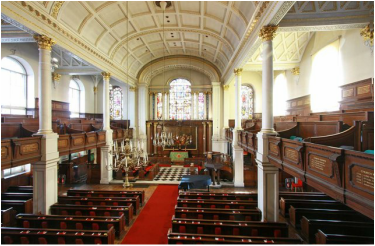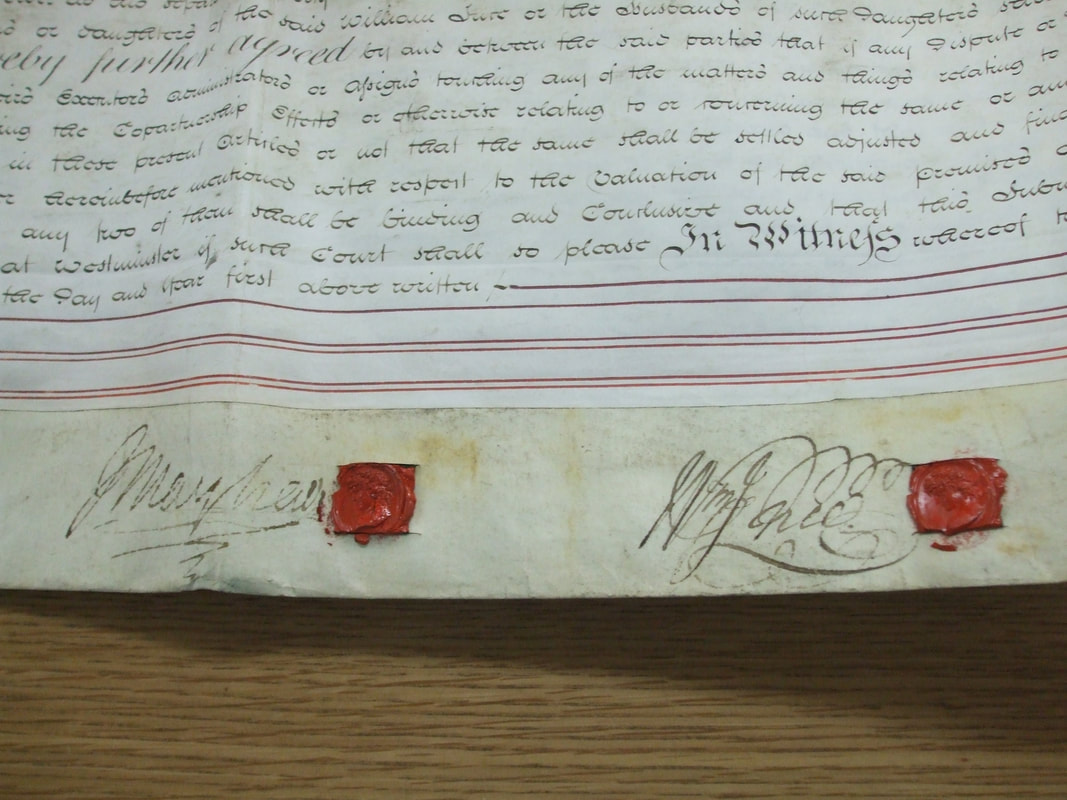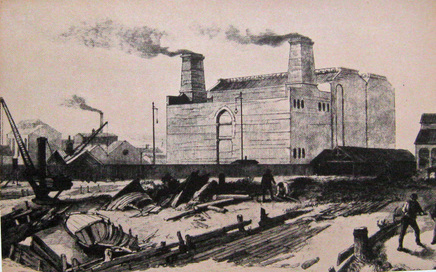|
It was a delight to receive a message from my American cousin Jodee James the other day. She has been researching the family of John Mayhew, partner of William Ince, and has discovered that the doctor son of William, Henry Robert Ince, married John Mayhew's first cousin once removed, Ann Elizabeth Saunders. Having found John Mayhew's mother's maiden name, Gray, hidden in his father's will, she discovered his mother was born, baptised and when first married was of the parish of St Mary the Virgin, Monken Hadley.
This answers a riddle that's been puzzling me for about six years. Why was John Mayhew's first wife, Isabella Stephenson, buried in Monken Hadley? The answer? Because her mother -in-law came from the parish. I was then able to answer a puzzle for Jodee. Henry Robert Ince and Ann Saunders lived in Presteigne and she wanted to know if there could be a link between the Mayhew family and a J Mayhew who took out a game licence in Presteigne in 1822 and 1824 and was then mentioned in an ad for a cottage to let with "valuable Modern Household Furniture, the residence of J Mayhew Esq." I knew that Irenaeus Mayhew, youngest son of John Mayhew, was living in Presteigne when the Land Registry document of 1825 was signed by all the parties involved in the Ince Mayhew court case. It is very likely that Irenaeus was the J Mayhew (I and J were often muddled) and he may well have introduced his second cousin Ann to Henry Robert Ince. I really enjoy this interweaving of the two families and receive great pleasure from my own connection with Ince Cousins all over the world. Advanced notice that the new edition of William Ince Cabinet Maker is nearing completion. The manuscript is finished and I am just waiting for a few copyright permissions for images. All going well there will be an official book launch in a couple of months and I hope to be able to make some preview copies available at a special discount price for anyone willing to write a review.
This book will be about twice the size of the original with a greater emphasis on celebrating the work of William Ince. It will also include new information on his father and sisters in Worcestershire, his wife’s family in London and his son Frederick’s remarkable adventure in America taken from the letters he wrote to his family back in England between 1824 and 1836. There will be a chapter on John Mayhew and his family, including new research on John’s baptism and his siblings, and information about his children and grandchildren, including royal dentists and the State Trials for High Treason. There will also be information on some of William’s more notable descendants, including the colourful actress Annette Ince, who played Juliet to John Wilkes Booth’s Romeo and the artists Joseph Murray Ince, Charles Percy Ince and Charlotte Grace Cowell. I will keep you posted. Two hundred and sixty years ago on this day, 25th December 1758, John Mayhew and William Ince officially entered into their partnership in the trade or Business of an Upholder and Cabinet Maker. It lasted well beyond the twenty-one years written into their agreement, as acknowledged in the agreement of 21st December 1799 which was all about how they would end the partnership. Sadly, it was not until around 1824 that a financial settlement was reached as recorded in my book William Ince, Cabinet Maker. This date is confirmed by the fact that William’s son Frederick, my great great great grand-father set off for America in October 1824, almost certainly because he finally had enough money to pay for his passage.
I am hoping to add an extra chapter to the book soon, detailing Frederick’s adventures in Virginia, with the young woman he travelled out with, and the story of the family he left behind and how they eventually brought Frederick to account. A story found in the wonderful letters written by Frederick to his family, owned by a distant cousin, Nigel Ince. Happy Christmas to all the Ince cousins – all around the globe! In my book on William Ince I stated that there were no apprentice records for his father, John Ince. Well, I was wrong!
I knew that John Ince was born in 1699 in the village of Stone in Worcestershire and moved to London where he worked as a glass-grinder. He died in 1746 and was buried back in Stone. Now thanks to the new database British and Irish Furniture Makers Online (BIFMO) I have found his apprentice records from the Joiners’ Company. In this record he was described as the son of William Ince, husbandman of Stone and was apprenticed to James Welch for seven years from 26th July 1720. I wondered how come a twenty-one year old from Worcestershire would be apprenticed to someone in London, so I looked up James Welch on the same database. There I found an apprentice record for a James Welch from Stourbridge, Worcestershire dated 1699. Stourbridge is only eight miles from Stone, so it seems very likely that the families knew one another. James was the son of Henry Welch, a tailor and was apprenticed to John Smalwell for 7 years, from 27 Feb 1699. However the record then says that this was turned over to John Wight Cit. & Haberdasher of London to learne the Art of a Joyner by consent, so at some stage of his apprenticeship James Welch went to London. He did well there and was Made free by servitude on 11 Nov 1718. On the report of Thomas Taxon Cit & Haberdasher of London and William Hayes Cit & Grocer of London the said Wight being out of Towne. (I am not sure how haberdashers taught him how to be a joiner.) He was at ‘The Rose & Crown’, Broadway in July 1724 when he advertised his ability to supply wholesale or retail a great Variety of Peer, Chimney or Sconce Glasses, fine Dressing-Glasses, Coach, Chariot or Chair-Glasses, with Plate Sash-Glasses &c. He also offered to clean and modernise old glasses. [Daily Courant, 29 July 1724] If John Ince completed his seven years apprenticeship he would have been working for James Welch in 1724, presumably as a glass-grinder. John and Mary Ince’s first child, Timothias, was born in 1725 and was baptised in St Faith’s Church, near St Paul’s Cathedral so hopefully John was earning a wage by then, and able to support his family. Their next child to be born was Elizabeth in 1728, by which time he would certainly have finished his apprenticeship. See Chapter 5 of William Ince Cabinet Maker for more details. It was a delight to come across some information about Charlotte Grace Cowell, grand-daughter of William Ince, who was a miniaturist painter. She was born on the 13th October 1811, daughter of George Cowell and Isabella Ince, who had married in St Mary’s Hornsey in 1795 when William Ince was Church Warden. Charlotte was the youngest of their six children.
In 1834-1835 she won the Silver Isis medal for an original miniature from the Royal Society of Arts. She exhibited at the Royal Academy in 1851, two portraits being listed against her name; the late Levi Ames, Esq. and the daughter of J.O.Hanson, Esq. She was described as Cowell Miss Grace Charlotte (afterwards Mrs F. Dixon) miniature painter of 12 Upper Gloucester Street. She married Frederick Henry Dixon on 11th October 1851, two days short of her 40th birthday, at St Martin’s in the Fields. Frederick was also a portrait painter. According to The Dictionary of British Women Artists[i] she was active between 1851 and 1875 having been instructed by Frederick Crucikshank a portrait painter and miniaturist and François Théodore Rochard (French, 1798-1858) who also produced portrait miniatures and watercolours. Bonhams sold a painting of hers in 2003. It was described as A bearded and bespectacled Gentleman, wearing black coat over white shirt and blue cravat signed on obverse and dated G Dixon 1873, and on the reverse, Mrs. F. Dixon/ Miniature Painter/ 1873, fitted red leather case Oval, 108mm. (4 1/4ins.) high Another surviving painting is a miniature portrait described as Oil on Ivory Portrait of a Toddler Holding a Rose, unsigned, but by Charlotte Dixon. On the obverse it is inscribed by Cowell Writing Painter Gilder No.16 Little New Street Shoe Lane Fleet Street According to the Dictionary of British Women Artists, Grace Cowell visited Paris, but travelled mostly around Britain, producing portraits in miniature, and large portrait heads in black and white chalk. Her portraits apparently included such subjects as the Madonna, Caesar Borgia and Richard Bethel, the Lord Chancellor. It was interesting to see in the 1841 census that her older unmarried sister was with their parents in Devon, but Grace is not there. She may have been out of the country as I cannot find her. It seems likely that her father gave her financial support; he was a wealthy city merchant. In his will, proved in 1846, he left everything to his wife, Isabella, to be divided between the children on her death ((apart from daughter Isabella who had received financial support on her marriage). Their mother died in the summer of 1852, so Grace would probably have been able to support herself and her painter husband. I have not yet found any surviving work by him. [i] Gray, Sara, The Dictionary of British Women Artists Lutterworth Press, 2009 I recently came across Pat Kirkham's book on Furniture Making in London in the Eighteenth Century[i]. There are a number of interesting facts about the firm Ince & Mayhew, many of which were included in her article for the Furniture History Society[ii].
However, one detail that had escaped me up to now was that when John Mayhew married Isabella Stephenson, she had a large dowry. Pat Kirkham writes: John Mayhew’s wife brought a large sum of money to her husband when they married in 1762, and, widowed within the year, Mayhew used approximately three thousand pounds of that money to finance his business. I am going to re-visit the National Archives to see if there is any further information on this, but it did help to explain why Isabella's sister, Ann, William's wife, had no hesitation about taking John Mayhew to court to get a fair settlement on the break-up of the partnership. She would no doubt have known all about that money, and would have regarded it as belonging equally to her family. No wonder she insisted on a more balanced final payment. [i] Kirkham, P. (1988). The London Furniture Trade 1700-1870. Furniture History, 24, I-219. Retrieved from http://www.jstor.org/stable/23406689 [ii] Kirkham, P.. (1974). The Partnership of William Ince and John Mayhew 1759—1804. Furniture History, 10, 56–60. Retrieved from http://www.jstor.org/stable/23403407 Francis Ince (1841-1920) one of William Ince’s great grandsons, played an important role in the introduction of electricity to the domestic home.
According to his daughter’s book[i], Francis was a practical man of business, by temperament excitable, impetuous and impatient of quick results. A lawyer by profession he was a passionate amateur scientist with a great interest in the technicalities of electrical science. In 1881 he met Sebastian de Ferranti, then aged 17, but already an ingenious inventor, who was then working for Siemens. Francis Ince recognised Ferranti’s talent and set him up in business with the company Ferranti, Thompson and Ince. Ferranti was a pioneer in electrical engineering, having grasped that electricity could be made on a large scale in one place and then distributed to all those who needed it. One of his aims was to use electricity to help women with their domestic chores. He was appointed to the London Electric Supply Corporation with Francis Ince on the Board of Directors. At the age of 24 he helped establish the world’s first high voltage AC power station at Deptford with the ability to create 10,000 volts. He also invented cables to carry high voltage electricity; the transformer to reduce the voltage for use and the voltmeter to measure use. This is much the same system that is still in use all over the world today. By 1893 Francis Ince was a Member of the Institution of Electrical Engineers, Director of the London Electric Supply Corporation and Chairman of S. Z. de Ferranti. In 1889 he had been amongst the party to meet Thomas Edison when he visited the Deptford works. Francis left Ferranti’s company in 1899, but they remained firm friends. Ferranti had married his daughter, Gertrude, in 1888 and was a support to Francis during his final illness. A blue plaque for Sebastian de Ferranti has recently been erected in his birthplace, Liverpool. An excellent explanation of his contribution to our world can be seen at http://www.sebastiandeferranti.co.uk and http://www.ferranti.me/sebastian-1864.html [i] Ziani de Ferranti, Gertrude and Ince, Richard, The Life and Letters of Sebastian Ziani de Ferranti, London 1934 I have added a family tree to the descendants page to show how I am connected to William Ince. There are a number of cousins, mostly descended from Charles Frederick Ince, some from Edward Bret Ince, who meet up from time to time with our families to view Ince & Mayhew furniture.
Fourteen direct descendants of William Ince went to Burghley in May 2013 and had a really good time being shown round by Jon Culverhouse, the curator. We were shown the wonderful commodes, collector’s cabinets, urns and pedestals, chairs etc. I most enjoyed being allowed to sit in an Ince & Mayhew chair. Last October some of us went to the Lady Lever Gallery in Liverpool, where there is a superb collection of Ince & Mayhew commodes, described in detail by Lucy Wood in her book, Catalogue of Commodes. After an entertaining tour of the gallery it was a delight to be able to spend time enjoying the workmanship and marvelling at the detail of the marquetry. This July we will be heading off to Broadlands in Hampshire, where the 2nd Viscount Palmerston had his country residence. Ince is mentioned in several of Palmerston’s letters and Lady Palmerston’s inventory of 1797 mentions a ‘Secretary made by Ince’. (Hugh Roberts, Country Life 29 January and 5 February 1981) It has also been a pleasure to find some cousins descended from Henry Robert Ince, William Ince’s doctor son. One lives in Worcestershire and helped me with some early research and now several of you in Pennsylvania are following this blog. It would be lovely to hear from any others.  Photo: John Salmon Photo: John Salmon Early on in my research I visited St George's Hanover Square in London. This is the church where John Mayhew and William Ince married the sisters Isabella and Ann Stephenson on 20th February 1762. The report in The London Chronicle refers to 'Nancy Stephenson', which lends an air of frivolity to her. All four signed the entries in the Parish Register, and the witnesses were John Mayhew's father and William Ince, for John and Isabella, and again John Mayhew's father and this time John Mayhew for William and Ann. The curate, Thomas Vincent, performed the service along with the other three marriages that took place that day. The marriages were permitted by licence, rather than the reading of Banns. As Nancy was only nineteen her mother signed a paper to confirm Nancy had no father living, and she gave her permission for the marriage to take place. Jean Stephenson wrote that she was too old and infirm to testify in person. As many a family historian will relate, to take time to sit quietly in the church where your ancestors were married is a moving experience. I found it good to ponder on their marriage, how young they all were, still in their teens and twenties, but presumably hopeful and excited about their future together. Sadly Isabella died within the year, but William and Nancy survived to the early nineteenth century, producing thirteen children, nine boys and four girls, of whom only six survived them. |
Author
Sarah Ingle is the great great great great grand-daughter of William Ince and has been researching her family history for a number of years. She thoroughly enjoyed the detective work involved in tracing William’s lineage. Archives
December 2022
Categories |



 RSS Feed
RSS Feed